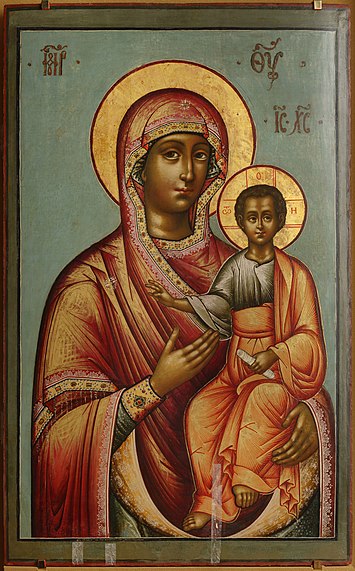
Fête
de l'Icône de la Mère de Dieu "JOIE DES AFFLIGES" (1688). (Office
traduit en français par le père Denis Guillaume au tome X du Supplément
aux Ménées.)
The wonderworking "Joy of All Who
Sorrow" Icon of the
Mother of God was glorified in the year 1688. Euphymia, the sister of
Patriarch Joachim (1674-1690), lived at Moscow and suffered from an
incurable illness for a long time. One morning during a time of prayer
she heard a voice say, "Euphymia! Go to the temple of the
Transfiguration of My Son; there you will find an icon called the "Joy
of All Who Sorrow." Have the priest celebrate a Molieben with the
blessing of water, and you will receive healing from sickness." Euphymia
did as she was directed by the Most Holy Theotokos, and she was healed.
This occurred on October 24, 1688.
The icon of the Mother of God "Joy of All Who Sorrow" (with coins fused to it by a bolt of lightning), was manifested at St Petersburg in 1888. See July 23.
L'icône miraculeuse de la Mère de Dieu "Joie de tous les Affligés" fut glorifiée en 1688. Euphymia, soeur du patriarche Joachim (1674-1690), vivait à Moscou et souffrait d'une maladie incurable depuis fort longtemps. Un matin, durant la prière, elle entendit une voix dire, "Euphymia! Va à l'église de la Transfiguration de Mon Fils; là tu trouveras une icône appelée "Joie de tous les Affligés". Fait célébrer un Moleben [ office d'intercession et d'action de grâce ] par le prêtre, avec de l'eau bénite [ agiasmos ], et tu recevras la guérison de ta maladie".
Euphymia ce que la Très Sainte Mère de Dieu lui avait dit de faire, et elle fut guérie. Ceci eut lieu le 24 octobre 1688.
The icon of the Mother of God "Joy of All Who Sorrow" (with coins fused to it by a bolt of lightning), was manifested at St Petersburg in 1888. See July 23.
L'icône miraculeuse de la Mère de Dieu "Joie de tous les Affligés" fut glorifiée en 1688. Euphymia, soeur du patriarche Joachim (1674-1690), vivait à Moscou et souffrait d'une maladie incurable depuis fort longtemps. Un matin, durant la prière, elle entendit une voix dire, "Euphymia! Va à l'église de la Transfiguration de Mon Fils; là tu trouveras une icône appelée "Joie de tous les Affligés". Fait célébrer un Moleben [ office d'intercession et d'action de grâce ] par le prêtre, avec de l'eau bénite [ agiasmos ], et tu recevras la guérison de ta maladie".
Euphymia ce que la Très Sainte Mère de Dieu lui avait dit de faire, et elle fut guérie. Ceci eut lieu le 24 octobre 1688.
http://www.ortodossia-russa.net/nostre_chiese/Brescia/icona_radost.htm
Kontakion
dell'icona, tono VI
Nessun
aiuto e nessuna speranza
abbiamo
al di fuori di te, o Signora.
Vieni
in nostro aiuto.
In
te speriamo e te glorifichiamo.
Che
nessuno di noi sia sviato
perchè
siamo i tuoi servitori.







